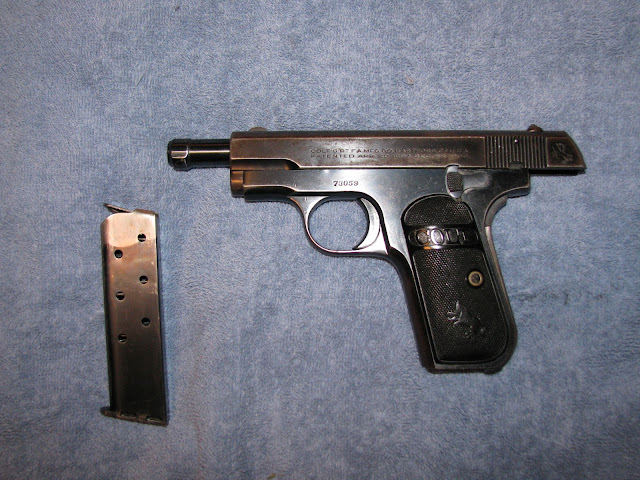From left to right: Colt model 1908 Pocket Hammerless; SIG-Sauer P232 and SIG-Sauer P238. The 1908 and P232 are blow-back fixed barrels, the P238 is short-recoil operated with a locking breech.
After emptying the magazine, the Colt will not lock open, the SIG's will.
The 1908 and the P232 have heel magazine releases, the P238 has a button behind the trigger. The 1908 and P232 hold seven rounds in the mag, the P238 six.
The 1908 is fiddly to take apart. You have to pull the slide to the rear and line up a mark with the front of the frame's dust-cover. Then, while holding it there, rotate the barrel to disengage it from the frame. Once you've done that, you just slide the slide off to the front. Reassembly is pretty much reversing those steps. It's a bit easier to describe than perform; especially the first time you try.
There are two safeties on this 1908, grip and thumb. The thumb safety doubles as a slide-lock. Later variations on the 1908 also got a magazine safety.
This is an original Colt magazine, the feed lips are hardened and don't take the blueing given to the rest of the magazine; giving it a two-tone look.
Although there's a slide-lock, it doesn't lock the slide back far enough to strip a round from the magazine. You have to pull the slide back another 1/8" to get it to feed. The safety also locks the slide closed when engaged.
The P232 is the easiest one to strip. Rotate the disassembly latch then work the slide while pulling upwards off the frame rails; then let everything go forward. Reassembly is just as simple, but in reverse.
While the slide does lock to the rear on the last round, there is no external control for it. It locks to the rear on an empty magazine only. Likewise the only way to unlock it is to pull the slide to the rear, where it will also strip a round from the magazine. There are no external safeties at all; just a decocking lever. The P232 is double action so the first round can be fired without cocking the hammer.
The extractor is also a loaded chamber indicator: here loaded.
Here: empty.
Field stripping the P238 is a lot like a M-1911. You pull the slide back and line up a notch in the slide with the end of the slide-lock; then push the slide-lock out of the side of the gun. Once that is done, the slide-barrel assembly can go forward and off the gun. Then you remove the recoil spring and its guide, then remove the barrel. Reassembly is the reverse with one small caveat. The P238 has both an external slide lock and safety. Unlike the M-1911 it resembles, the safety doesn't lock the slide closed when engaged.
This is the ejector, it folds down into the frame until needed during firing, or when disassembled. When you're putting the gun back together you have to push it down to clear the slide.
Pushing down on the slide-lock will strip a round from the magazine.
The rear of the barrel is cut so you can see if there's a round in the chamber.
The Colt's sights are very small and hard to see, but if you get them lined up it's very accurate. The P232 has easy-to-see three-dots. The P238 has tritium inserts. All three have been reliable and accurate with Speer Gold-Dot hollow points. The P232 fits my hand best, the P238 gets carried more.
I did carry the Colt in my pocket for quite a while before replacing it with the P238. The P232 was a regularly carried gun as well, in a Galco Executive shoulder holster before I decided that I could carry a 1911 in a shoulder holster just as easily.
I've also just discovered that the P232's shoulder holster carries the Colt just as well!





















No comments:
Post a Comment
You are a guest here when you comment. This is my soapbox, not yours. Be polite. Inappropriate comments will be deleted without mention. Amnesty period is expired.
Do not go off on a tangent, stay with the topic of the post. If I can't tell what your point is in the first couple of sentences I'm flushing it.
If you're trying to comment anonymously: You can't. Log into your Google account.
If you can't comprehend this, don't comment; because I'm going to moderate and mock you for wasting your time.